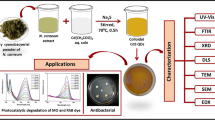Abstract
Luminescent zirconia quantum dots (ZQDs) were prepared by wet leaf extract of Spinacia oleracea plant with varying ultrasonication treatment reaction time. The results of characterization studies on ZQDs revealed that particles are in monoclinic and tetragonal phase with the small spherical shape exhibiting blue–green and orange red emission properties. Electrochemical impedance and cyclic voltammetry studies were carried out, resulting in good electrocatalytic activity of ZQDs. Cellular mitochondrial activity was determined by MTT assay, anti-oxidant capability was determined using DPPH assay and in-vitro antibacterial activity studies were performed on Gram-negative E. coli bacteria and Gram-positive bacteria Bacillus subtilis for ZQDs. Biological studies on ZQDs revealed Ultrasonic 10 min (US-10) as a potential anti cancer agent against human cancer cell line (MCF-7) with an IC 50 value of 59.70 µg/mL, anti-oxidant agent with IC 50 value of 170 µg/mL and antibacterial agent showing good inhibition zones against E. coli and B. subtilis.










Similar content being viewed by others
References
C. Piconi, G. Maccauro, Zirconia as a ceramic biomaterial. Biomaterials 20, 1–25 (1999)
G.M. Whitesides, Nanoscience, nanotechnology and chemistry. Small 1, 172–179 (2005)
A. Paul, Chemical durability of glasses; a thermodynamic approach. J. Mater. Sci. 12, 2246–2268 (1977)
A.K. Khan, R. Rashid, G. Murtaza, A. Zahra, Gold nanoparticles: synthesis and applications in drug delivery. J. Pharmaceut. Res. 13(7), 1169–1177 (2014)
L. Xiangqian, X. Huizhong, Z.-S. Chen, G. Chen, Biosynthesis of nanoparticles by microorganisms and their applications. J. Nanomater. (2011). https://doi.org/10.1155/2011/270974. (Article ID 270974)
T. Sreethawong, S. Ngamsinlapasathian, S. Yoshikawa, Synthesis of crystalline mesoporous assembled ZrO2 nanoparticles via a facile surfactant-aided sol–gel process and their photocatalytic dye degradation activity. Chem. Eng. J. 228, 256–262 (2013)
J.R. Sohn, S.G. Ryu, Surface characterization of chromium oxide-zirconia catalyst. Langmuir 9, 126–131 (1993)
E. Dudnik, Modern methods for hydrothermal synthesis of ZrO2-based nano crystalline powders. Powder Metall. Met. Ceram. 48, 238–248 (2009)
R.R. Bhosale, A.S. Kulkarni, S.S. Gilda, N.H. Aloorkar, R.A. Osmani, B.R. Harkare, Innovative eco-friendly approaches for green synthesis of silver nanoparticles. Int. J. Pharmaceut. Sci. Nanotechnol. 7(1), 2328–2337 (2014)
V. Bansal, D. Rautaray, A. Ahmad, M. Sastry, Biosynthesis of zirconia nanoparticles using the ungus Fusarium oxysporum. J. Mater. Chem. 14, 3303–3305 (2004)
M. Satishkumar, K. Sneha, Y.S. Yun, Green fabrication of zirconia nano-chains using novel Curcuma longa tuber extract. Mater. Lett. 98, 242–245 (2013)
S. Balajia, B.K. Mandala, S. Ranjan, N. Dasguptab, R. Chidambaram, Nano-zirconia—evaluation of its antioxidant and anticancer activity. J. Photochem. Photobiol. B 170, 125–133 (2017)
M. Kumerasan, V.K. Anand, K. Govindaraju, S. Tamilselvan, G.V. Kumar, Seaweed Sargassum wightii mediated preparation of zirconia (ZrO2) nanoparticles and their antibacterial activity against gram positive and gram negative bacteria. Microb. Pathog. 124, 311–315 (2018)
X. Vendrell, A.R. West, Electric properties of Yttria-stabilized Zirconia, YSZ single crystal, local AC and long range DC Conduction. J. Electrochem. Soc. 165, 966–975 (2018)
D. Eder, R. Kramer, Impedance spectroscopy of reduced monoclinic zirconia. Phys. Chem. Chem. Phys. 8, 4476–4483 (2006)
Y. Qiang, Q. Minghui, C. Xianfu, F. Yiqun, Ultrasound assisted synthesis of size—controlled aqueous colloids for the fabrication of nanoporous Zirconia membrane. Front. Chem. (2019). https://doi.org/10.3389/fchem.2019.00337
M.L. Andrade-Guel, L. Diaz-Jimenez, D.A. Cortes-Hernández, Ultrasound-assisted sol-gel synthesis of ZrO2. Ultrasonics Sonochem. 35, 514–517 (2017). https://doi.org/10.1016/j.ultsonch.2016.09.010
T.M. Taghizadeh, M. Vatanparast, Ultrasonic-assisted synthesis of ZrO2 nanoparticles and their application to improve the chemical stability of Nafion membrane in proton exchange membrane (PEM) fuel cells. J. Colloid Interface Sci. 483, 1–10 (2016)
D. Manoharan, A. Loganatham, V. Kurapati, J.V. Nesamony, Unique sharp photoluminescence of size-controlled sonochemically synthesized zirconia nanoparticles. Ultrason. Sonochem. 23, 174–184 (2015)
K. Prasad, D. Pinjari, B.A. Pandit, S. Mhaske, Synthesis of zirconium dioxide by ultrasound assisted precipitation: effect of calcination temperature. Ultrason. Sonochem. 18(5), 1128–1137 (2011)
G.D. Reddy, M. Noorjahan, A. Ratnamala, Novel visible-range luminescence of pristine nanozirconia phosphor using green fabrication techniques. Bull. Mater. Sci. 42, 34 (2019)
A. Miri, M. Sarani, Silver nanoparticles: cytotoxic and apoptotic activity on HT-29 and A549 cell lines. J. New Develop. Chem. 4, 10 (2018)
A.A. Kajani, A.K. Bordbar, S.H.Z. Esfahani, A. Razmjou, Green synthesis of anisotropic silver nanoparticles with potent anticancer activity using Taxus baccata extract. RSC Adv. 4, 61394–61403 (2014)
S. Soren, S. Kumar, S. Mishra, P.K. Jena, S.K. Verma, P. Parhi, Evaluation of antibacterial and antioxidant potential of the zinc oxide nanoparticles synthesized by aqueous and polyol method. Microb. Pathog. 119, 145–151 (2018)
K. Chokshi, I. Panch, T. Ghosh, C. Paliwal, R.M.A. Ghosh, S. Mishra, Green synthesis, haracterization and antioxidant potential of silver nanoparticles biosynthesized from de-oiled biomass of thermotolerant oleaginous microalgae Acutodesmus dimorphus. RSC Adv. 6, 72269–72274 (2016)
Y. Kuthati, R.K. Kankala, S.X. Lin, C.F. Weng, C.H. Lee, pH-Triggered controllable release of silver–indole-3 acetic acid complexes from mesoporous silica nanoparticles (IBN-4) for effectively killing malignant bacteria. Mol. Pharm. 12, 2289–2304 (2015)
J.B. Fathima, A. Pugazhendhi, R. Venis, Synthesis and characterization of ZrO2 nanoparticles-antimicrobial activity and their prospective role in dental care. Microb. Pathog. 110, 245–251 (2017)
S. Gowri, R.R. Gandhi, M. Sundarajan, Structural, optical, antibacterial and antifungal properties of zirconia nanoparticles by biobased protocol. J. Mater. Sci. Technol. 30(8), 782–790 (2014)
M. Imran, S. Riaz, I. Sanaullah, U. Khan, A.N. Sabri, S. Naseem, Microwave assisted synthesis and antimicrobial activity of Fe3O4-doped ZrO2 nanoparticles. Ceram. Int. (2019). https://doi.org/10.1016/j.ceramint.2019.02.057
R.C. Gravie, The occurrence of metastable tetragonal zirconia as a crystallite size effect. J. Phys. Chem. 69, 1238–1243 (1965)
L. Kumari, W.Z. Li, Controlled hydrothermal synthesis of zirconium oxide nanostructures and their optical properties. Cryst. Growth Des. 9, 3874–3880 (2009)
G.K. Sidhu, A.K. Kaushik, S. Rana, S. Bhansali, R. Kumar, Photoluminescence quenching of Zirconia nanoparticle by surface modification. Appl. Surf. Sci. 334, 216–221 (2015)
A. Mftah, F.H. Alhassan, M.S. Al-Qubaisi, M.E. El Zowalaty, T.J. Webster, M. Sh-eldin, A. Rasedee, Y.H. Taufiq-Yap, S.S. Rashid, Physicochemical properties, cytotoxicity and antimicrobial activity of sulphated zirconia nanoparticles. Int. J. Nanomed. 10, 765–774 (2015)
G. Bisht, S. Rayamajhi, ZnO nanoparticles: a promising anticancer agent. Nanobiomedicine (Rij) 3, 9 (2016). https://doi.org/10.5772/63437
P.V. Rao, D. Nallapan, K. Madhavi, S. Rahman, L.J. Wei, S.H. Gan, Phytochemicals and biogenic metallic nanoparticles as anticancer agents. Oxidative Med. Cell. Longevity 15, 3685671 (2016)
N.E.A. El-Naggar, M.H. Hussein, A.A. El-Sawah, Bio-fabrication of silver nanoparticles by phycocyanin, characterization, in vitro anticancer activity against breast cancer cell line and in vivo cytotxicity. Sci. Rep. 7(2017), 10844 (2017). https://doi.org/10.1038/s41598-017-11121
S. Paul, J.P. Saikia, S.K. Samdarshi, B.K. Konwar, Investigation of antioxidant property of iron oxide particlesby 1′-1′ diphenylpicryl-hydrazyle (DPPH) method. J. Magn. Magn. Mater. 321, 3621–3623 (2009)
N. Pandiyan, B. Murugesan, J. Sonamuthu, S. Samayanan, S. Mahalingam, Facile biological synthetic strategy to morphologically aligned CeO2/ZrO2 core nanoparticles using Justicia adhatoda extract and ionic liquid: enhancement of its bio-medical properties. J. Photochem. Photobiol. B. 178, 481–488 (2018)
T. Xia, M. Kovochich, J. Brant, M. Hotze, J. Sempf, T. Oberley, C. Sioutas, J.I. Yeh, M.R. Wiesner, A.E. Nel, Comparison of the abilities of ambient and manufactured nanoparticles to induce cellular toxicity according to an oxidative stress paradigm. Nano Lett. 6(8), 1794–1807 (2006)
H. Manjunatha, D.H. Nagaraju, G.S. Suresh, T.V. Venkatesh, Detection of uric acid in the presence of dopamine and high concentration of ascorbic acid using PDDA modified graphite electrode. Electroanalysis 21(20), 2198–2206 (2009)
Acknowledgements
The Authors are grateful to DST-Inspire (AORC) Fellowship for providing financial assistance. Also Authors acknowledge Prof. K. Girija, Department of Chemistry, Palamuru University for Encouragement and National Dong Hwa University, Taiwan for providing FESEM characterization.
Author information
Authors and Affiliations
Corresponding authors
Additional information
Publisher's Note
Springer Nature remains neutral with regard to jurisdictional claims in published maps and institutional affiliations.
Rights and permissions
About this article
Cite this article
Reddy, G.D., Noorjahan, M., Ratnamala, A. et al. Electrochemical characterization and biological applications of luminescent zirconia quantum dots. Appl. Phys. A 126, 745 (2020). https://doi.org/10.1007/s00339-020-03942-3
Received:
Accepted:
Published:
DOI: https://doi.org/10.1007/s00339-020-03942-3




